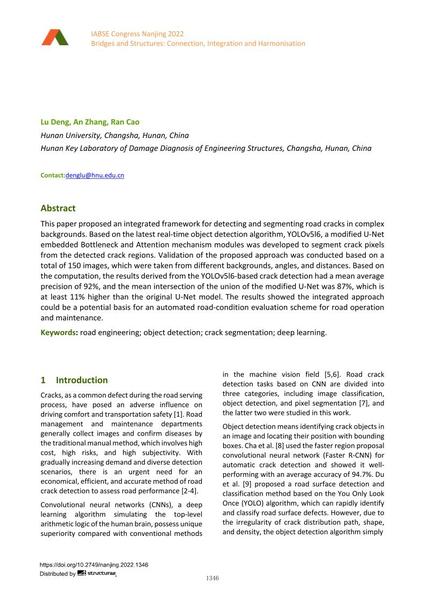Pixel-level Road Crack Detection and Segmentation Based on Deep Learning

|
|
|||||||||||
Détails bibliographiques
| Auteur(s): |
Lu Deng
(Hunan University, Changsha, Hunan, China; Hunan Key Laboratory of Damage Diagnosis of Engineering Structures, Changsha, Hunan, China)
An Zhang (Hunan University, Changsha, Hunan, China; Hunan Key Laboratory of Damage Diagnosis of Engineering Structures, Changsha, Hunan, China) Ran Cao (Hunan University, Changsha, Hunan, China; Hunan Key Laboratory of Damage Diagnosis of Engineering Structures, Changsha, Hunan, China) |
||||
|---|---|---|---|---|---|
| Médium: | papier de conférence | ||||
| Langue(s): | anglais | ||||
| Conférence: | IABSE Congress: Bridges and Structures: Connection, Integration and Harmonisation, Nanjing, People's Republic of China, 21-23 September 2022 | ||||
| Publié dans: | IABSE Congress Nanjing 2022 | ||||
|
|||||
| Page(s): | 1346-1352 | ||||
| Nombre total de pages (du PDF): | 7 | ||||
| DOI: | 10.2749/nanjing.2022.1346 | ||||
| Abstrait: |
This paper proposed an integrated framework for detecting and segmenting road cracks in complex backgrounds. Based on the latest real-time object detection algorithm, YOLOv5l6, a modified U-Net embedded Bottleneck and Attention mechanism modules was developed to segment crack pixels from the detected crack regions. Validation of the proposed approach was conducted based on a total of 150 images, which were taken from different backgrounds, angles, and distances. Based on the computation, the results derived from the YOLOv5l6-based crack detection had a mean average precision of 92%, and the mean intersection of the union of the modified U-Net was 87%, which is at least 11% higher than the original U-Net model. The results showed the integrated approach could be a potential basis for an automated road-condition evaluation scheme for road operation and maintenance. |
||||
| Copyright: | © 2022 International Association for Bridge and Structural Engineering (IABSE) | ||||
| License: | Cette oeuvre ne peut être utilisée sans la permission de l'auteur ou détenteur des droits. |
||||
